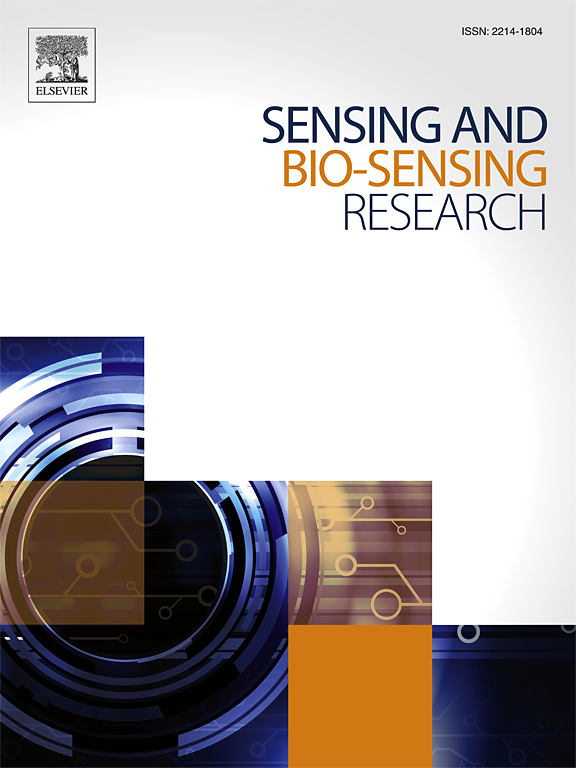混合配体聚(Co(II)-邻菲罗啉,二间苯二甲酸酯)修饰电极对药物和血清中阿莫西林和扑热息痛的选择性同时电化学检测
IF 5.4
Q1 CHEMISTRY, ANALYTICAL
引用次数: 0
摘要
过渡金属配位化合物由于具有高灵敏度、选择性、导电性和更大的表面积等特点,正成为检测各种电活性分析物的良好替代电极改性剂。本研究报告了使用间苯二甲酸酯(HR−)和1,10-菲罗啉(phen)精心设计和制备的钴(II)配合物,其化学式为Co(HR)2(phen) (DHRPCo),具有电活性和四面体几何结构。后一种性质对于其易于聚合和赋予电极表面多孔性是重要的。利用该配合物制备了基于金属配合物的聚合物膜修饰电极,用于同时分析阿莫西林(AMX)和扑热息痛(PTM)。采用循环伏安法和电化学阻抗谱法,确定了动态电位(采用电位范围)合成聚(二间苯二甲酸-1,10-菲罗啉钴(II))修饰玻碳电极(poly(DHRPCo)/GCE)的可行性。在AMX和PTM的等摩尔组合中,聚(DHRPCo)/GCE显示出充分分离的氧化峰,峰值电流显著提高,表明与未修饰的GCE相比,聚合物膜对AMX和PTM的氧化具有电催化性能。在最佳pH和方波伏安配置下,聚(DHRPCo)/GCE电极对浓度为0.01 ~ 400.0 μM的AMX和PTM具有线性氧化峰电流响应。AMX的检出限为20.50 nM, PTM为4.03 nM。AMX和PTM的干扰回收率分别为99.00% ~ 100.45%和99.33% ~ 100.05%,干扰回收率均小于4.84%。该技术显示了出色的电极稳定性,并且在片剂样品中AMX和PTM的检测值与标称值之间具有高度的一致性。这些结果证实了开发的方法在不同现实世界样品中同时定量AMX和PTM的可靠性。其在药物片剂和人血清中的应用进一步突出了其作为有效分析工具的潜力。本文章由计算机程序翻译,如有差异,请以英文原文为准。
Selective and simultaneous electrochemical detection of amoxicillin and paracetamol in pharmaceuticals and serum using a mixed-ligand poly(Co(II)-phenanthroline, diresorcinate) modified electrode
Transition metal coordination compounds are emerging as good alternative electrode modifiers for detection of various electroactive analytes due to their several appropriate features such as that they can provide high sensitivity, selectivity, electrical conductivity, and a larger surface area. This study reports the use of carefully designed and prepared cobalt(II) complex using resorcinolate (HR−) and 1,10-phenanthroline(phen) having a formula of Co(HR)2(phen) (DHRPCo), with electroactivity and a tetrahedral geometry. The later properties are important for its easy polymerization and impart porous surface on the electrode surface. This complex was used for the fabrication of metal complex-based polymer film-modified electrode for the simultaneous analysis of amoxicillin (AMX) and paracetamol (PTM). Using cyclic voltammetric and electrochemical impedance spectroscopy methods, the potentiodynamic (employing a potential range) synthesis of poly(diresorcinate-1,10-phenanthrolinecobalt(II)) modified glassy carbon electrode (poly(DHRPCo)/GCE) was confirmed. The poly(DHRPCo)/GCE in an equimolar combination of AMX and PTM showed adequately separated oxidative peaks with significantly improved peak current, indicating the polymer film's electrocatalytic property towards the oxidation of AMX and PTM, as compared to the unmodified GCE. The poly(DHRPCo)/GCE electrode demonstrated a linear oxidative peak current response to AMX and PTM concentrations ranging from 0.01 to 400.0 μM under optimum pH and square wave voltammetric configurations. The detection limits were 20.50 nM for AMX and 4.03 nM for PTM. While interference recovery errors were less than 4.84 % for both analytes, the range of spike recovery rates for AMX and PTM was 99.00 % to 100.45 % and 99.33 % to 100.05 %, respectively. The technique showed outstanding electrode stability and a high degree of agreement between the detected and nominal values of AMX and PTM in tablet samples. These results confirm the reliability of the developed approach for simultaneous quantification of AMX and PTM in diverse real-world samples. Its application to pharmaceutical tablets and human blood serum further highlights its potential as an effective analytical tool.
求助全文
通过发布文献求助,成功后即可免费获取论文全文。
去求助
来源期刊

Sensing and Bio-Sensing Research
Engineering-Electrical and Electronic Engineering
CiteScore
10.70
自引率
3.80%
发文量
68
审稿时长
87 days
期刊介绍:
Sensing and Bio-Sensing Research is an open access journal dedicated to the research, design, development, and application of bio-sensing and sensing technologies. The editors will accept research papers, reviews, field trials, and validation studies that are of significant relevance. These submissions should describe new concepts, enhance understanding of the field, or offer insights into the practical application, manufacturing, and commercialization of bio-sensing and sensing technologies.
The journal covers a wide range of topics, including sensing principles and mechanisms, new materials development for transducers and recognition components, fabrication technology, and various types of sensors such as optical, electrochemical, mass-sensitive, gas, biosensors, and more. It also includes environmental, process control, and biomedical applications, signal processing, chemometrics, optoelectronic, mechanical, thermal, and magnetic sensors, as well as interface electronics. Additionally, it covers sensor systems and applications, µTAS (Micro Total Analysis Systems), development of solid-state devices for transducing physical signals, and analytical devices incorporating biological materials.
 求助内容:
求助内容: 应助结果提醒方式:
应助结果提醒方式:


